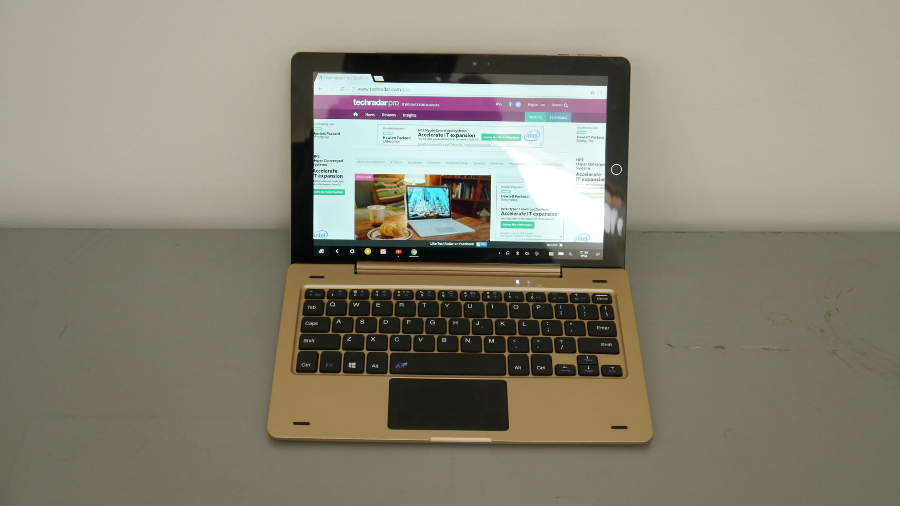Early Verdict
Remix OS is a refreshing operating system but the impending merger between Chrome OS and Android may well make it less attractive, except if you plan to use it for x86. As for the OBook, while it is a decent little tablet, there are better options elsewhere.
Pros
- +
Remix OS is great
- +
Keyboard is more than decent
Cons
- -
No rear camera
- -
Proprietary power connector
- -
Expensive
Why you can trust TechRadar
New operating systems are often greeted with scepticism, especially since, as is the case with browsers, the investment is colossal and the ROI uncertain given the necessary time it takes for them to embed in the market.
Earlier this year, a little known startup, Jide, announced that it was releasing a new OS based on the Android-x86 project which ported AOSP (Android Open Source Project) to the x86 platform (Intel and AMD).
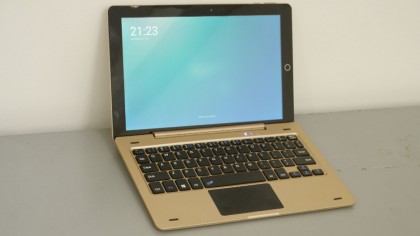
Jide is backed by Foxconn, one of the biggest technology manufacturers in the world, and was founded by ex-Google employees. So it's not going to vanish anytime soon.
The project usually lags behind its ARM-based counterpart by a few months but the thriving community means that it won't disappear overnight. With a regular release cycle, Remix OS is shaping up to be a nice little rival for Google's own Chrome OS.
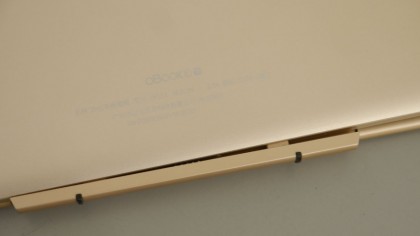
Both of them have a predilection for keyboard-enabled devices and x86 platforms. Remix OS, however, allows Android to run on far more powerful hardware than is available in the ARM ecosystem.
That means having access to systems with far more cores/threads and even multiple sockets as well as other resources like GPGPUs – confirmed by Jide. All this while remaining free forever and offering access to hundreds of thousands of Android applications.
But that's not all. Remix OS looks a lot like Windows, with a very familiar appearance and feel. There's a file manager, a start button and a taskbar, as well as a number of improvements under the hood like multitasking and windowing.
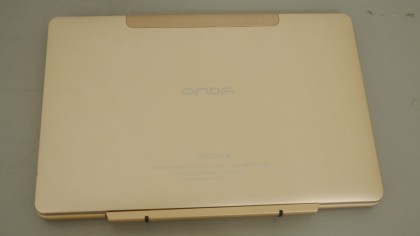
That very long preamble to this hands-on evaluation of the Onda OBook 10 SE was necessary to give a background on the operating system that powers it.
The review sample was provided by Gearbest. The retailer sells it for £102 (around $135, AU$178) with free shipping but no taxes. We strongly advise you to read our article on the pros and cons of buying from Chinese retailers (and generally speaking, outside of the UK).
The Onda OBook 10 SE tablet runs Remix OS 2.0 which is based on Android 5.1 Lollipop; a Marshmallow update (Android 6.0) should be available soon. It is a reasonably well-designed tablet that suffers from one major flaw – it doesn't have a rear camera.
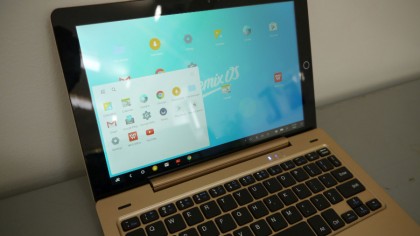
This device looks and feels like a traditional 10.1-inch Windows tablet without the dedicated Windows key. There's even an optional keyboard – with a Windows keyboard key – which costs an extra £28.92, bringing the total price of the combination to about £131 (around $172, AU$229), depending on the exchange rate.
The tablet adopts a flashy gold champagne colour scheme with a reasonably small bezel, a full HD webcam, a 10.1-inch glass-covered 1280 x 800 pixel display and a lonely circular capacitive home button at the front.
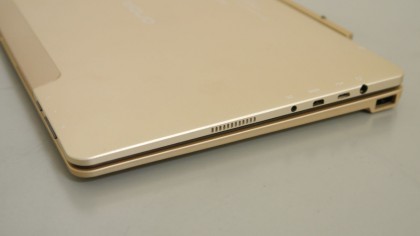
On the sides are connectors for the keyboard dock, a microSD card slot, audio connector, microUSB, microHDMI, a DC power socket, the power button, volume rocker buttons and a speaker grill.
Overall, it's a well-built tablet although the hardware inside is a bit long in the tooth. There's an Intel Atom Z3735F (from January 2014), 2GB of RAM, 32GB on-board storage, a 5,400mAh battery, 802.11n Wi-Fi and Bluetooth.
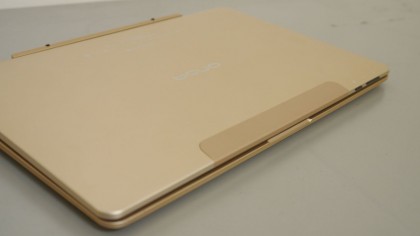
The optional keyboard contains an additional USB port and a multimodal rotary shaft which allows the tablet to be docked in a traditional laptop mode, or in a stand mode.
More importantly perhaps, it provides a small but useful touchpad and keys that, despite being tiny and wobbly, are better than those on the Surface-like magnetic keyboards which have flooded the market.
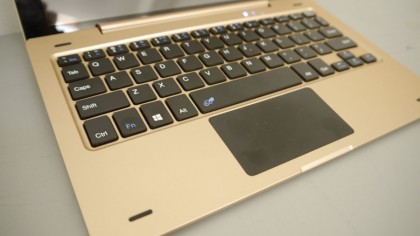
The keys offer very decent feedback and, while some might not fall in love with the keyboard, it was heavier than we expected which translated into better stability, especially if you plan to type for long periods.
As for the overall experience of Remix OS, it felt natural. If you have used Windows on desktop and Android on a tablet or smartphone, then what awaits you won't come as a surprise.
You will be in familiar territory. Interestingly, Jide has a Remix Central zone which is a folder containing a few select applications including three from Microsoft but no YouTube.
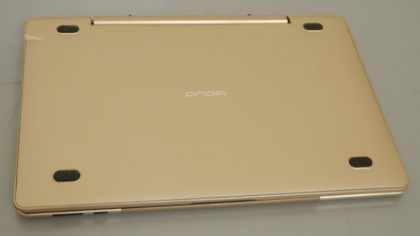
Some apps will support windowing but none of the ones coming from Google Play do. You are likely to encounter issues with some Android apps which might not support Remix OS. A useful memory clean-up feature allows you to claim back RAM, closing running apps.
A quick test using Antutu showed that the Z3735F ranked behind the original OnePlus One with a score of 52,665. At no time during our brief inspection of the Onda OBook 10 SE did we experience lagging or freezing, even given the low amount of memory and the antiquated processor.
We couldn't get the trackpad on the docking station to work sadly.
Early verdict
Here is our two-part verdict. Firstly, the tablet. It is unfortunately far too expensive – and based on old technology – to earn any recommendation from us. Ebuyer sells the similarly configured Asus Transformer T100TAF for cheaper. The Asus model wins on brand recognition, aftersales, a higher screen resolution and it has Windows 10 bundled.
Since you can dual-boot Remix OS with a pre-existing operating system, nothing prevents you from downloading and installing it alongside Windows 10. Hey presto – a winning solution…
As for our first encounter with Remix OS, it went surprisingly well. If traditional Linux distributions have put you off, then Remix OS may well be the panacea.
It is Android but done differently – the fact that our Onda tablet came with Google Play and Google Chrome as default means that Google may have tacitly approved Jide's move despite the Chrome OS rivalry.
Many of our peers have predicted great things for this little OS and given the rising number of devices that run with it as default (Vensmile, Cube, Unuiga, MXQ and Chuwi), it wouldn't be surprising if either Microsoft or Google end up investing in or acquiring Jide.

Désiré has been musing and writing about technology during a career spanning four decades. He dabbled in website builders and web hosting when DHTML and frames were in vogue and started narrating about the impact of technology on society just before the start of the Y2K hysteria at the turn of the last millennium.
What is a hands on review?
Hands on reviews' are a journalist's first impressions of a piece of kit based on spending some time with it. It may be just a few moments, or a few hours. The important thing is we have been able to play with it ourselves and can give you some sense of what it's like to use, even if it's only an embryonic view. For more information, see TechRadar's Reviews Guarantee.
